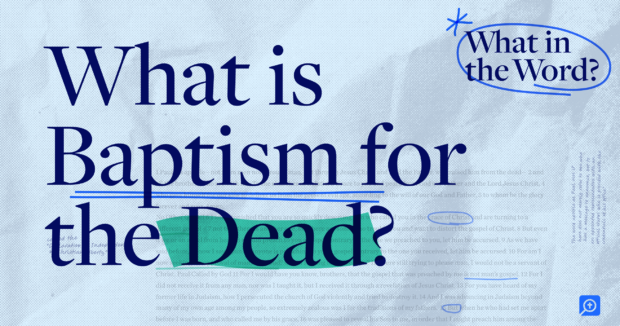On this episode of What in the Word?, we dive into probably the most puzzling verses within the New Testomony: 1 Corinthians 15:29 and its reference to “baptism for the lifeless.” Host, Kirk E. Miller, is joined by biblical scholar, B. J. Oropeza, to discover numerous interpretations in addition to key exegetical insights that unlock the which means of this cryptic passage.
Tune in to realize sensible insights for decoding, making use of, and educating this verse that has sparked debate for hundreds of years!
Observe the present on YouTube, Spotify, Apple Podcasts, and extra.
Particular Presents


A Free E-book Only for You
Logos has given away over 5 million free books, empowering Christians globally to review deeply. Get a shiny, new free guide each month!


Unique Lexham Press Robust Texts Bundle
Have extra questions in regards to the Bible? Get the 10-volume Lexham Press Robust Texts Bundle designed completely for followers of What within the Phrase?
Join with us
Prepared to extend biblical literacy? Like and share. To go the additional mile, go away us a evaluate in your most popular platform.
Subscribe to get future episodes. (Bonus: We’ll ship you a reduction to make use of in your first buy.)
Thanks for subscribing to Phrase by Phrase!
Use code WORDBYWORD to avoid wasting 10% in your first order.
WORDBYWORD
Copy code
Episode visitor: B. J. Oropeza
B. J. Oropeza (PhD, Durham College, England) is Professor of Biblical and Spiritual Research at Azusa Pacific College and Seminary. His present specialties embody Romans, intertextuality, and views on Paul.
His publications embody Perspectives on Paul: Five Views (Baker Educational), Practicing Intertextuality (Cascade), contributions to the Scripture, Texts, and Tracings series (Fortress Educational), in addition to commentaries on each 1 and a couple of Corinthians. He’s participated on Bible translation groups for the NRSV (updated edition), Common English Bible (CEB), and Lexham English Septuagint (LES).
Episode synopsis
Introduction
Kirk E. Miller raises the peculiarity and issue surrounding this reference to baptism on behalf of the lifeless talked about in 1 Corinthians 15:29. Kirk mentions the bizarre nature of 1 Corinthians 15:29 and the quite a few interpretations it has elicited. Students have recognized not less than 40 completely different views, with some estimates going as much as 200 completely different interpretations.
Substitutionary view
One of many conventional views is that folks have been being baptized on behalf of the deceased. B. J. and Kirk define a number of the arguments for and towards this interpretation, together with theological, exegetical, and historic observations. The dialog touches on points with the Greek preposition ὑπέρ and explores how early church fathers seen the observe.
The metaphorical possibility
One other interpretation means that Paul’s language of “baptism” and “the lifeless” is metaphorical, referencing martyrdom or apostolic sacrifice for spiritually lifeless people.
Martin Luther’s interpretation
Luther understood 1 Corinthians 15:29 to check with baptisms going down over graves, though no historic proof exists to counsel this observe ever occurred.
In view of the hope of resurrection
Some views emphasize Christian baptism’s connection to the hope of resurrection (see Romans 6). They take the phrase, “baptism for the lifeless,” to contain an ellipses or check with the hope that baptism holds out: resurrection.
The affect of lifeless Christians
Lastly, others interpret the verse as referring to now-deceased Christians whose affect led to the conversion of these now being baptized. The latter are thus baptized on account of the testimony of “the lifeless.”
Context and argument
After surveying these views, B. J. explains the bigger context of 1 Corinthians 15. Its central themes are the resurrection of Jesus and the final resurrection. B. J. showcases Paul’s use of an ABA sample in 1 Corinthians, together with right here in chapter 15, which helps inform our interpretation of his argument. Kirk mentions using reductio advert absurdum arguments all through 1 Corinthians, each theologically as regards to Christ’s resurrection (1 Cor 15:12 ff) then later with reference to this observe of baptism for the lifeless (1 Cor 15:29).
Noting the shift in pronouns
B. J. notes the necessary shift to 3rd individual pronouns, linking the “some” of v. 29 with the “some” of v. 34. Paul’s language shifts from first individual (“we,” “I”) to “they,” hinting at a attainable distancing and implied rebuke of their observe. He connects the “some” in Corinth who deny resurrection (see 1 Cor 15:12) with the “some” who don’t have any information of God later within the passage. B.J., due to this fact, means that Paul doesn’t endorse this observe of “baptism for the lifeless,” and may need deliberate to appropriate the Corinthians in individual later (evaluate 1 Cor 11:34).
The usage of ὑπέρ
B.J. notes how ὑπέρ is used throughout 1 Corinthians the place it mostly has the concept of substitution, which provides extra assist to this studying.
Educating suggestions
Kirk and B. J. encourage preachers to emphasise the resurrection of Jesus and keep away from getting hung up on v. 29. Give attention to the bodily resurrection as the numerous theological level fairly than controversial interpretations. No matter one’s interpretation, the contribution of v.29 to Paul’s general argument will stay the identical.
Choose works from B. J. Oropeza
Source link














